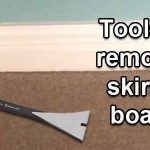Skirting boards can be fixed in several different ways. The exact method of fixing will depend on the surface you are fixing too. However, screws are almost always an option.
The best screws for fixing skirting boards are countersunk multi-purpose screws. The ideal length is between 50-65mm.
A shorter screw will be fine if you are fixing directly into timber studwork. However, a slightly longer screw would be better if you are fixing into masonry. To do this you will need to drill a hole and insert wall plugs to fix your screws into.

By using a counter sunk screw, you will make sure the screw head finishes below the surface of the skirting board. This will make it easier to fill and decorate.
Other ways of fixing skirting boards
Whilst screws are a good option for fixing skirting boards, they are not the only option. It is also arguable, that they are not the best option in most cases. Some other fixing options can be seen below:
Fixing with 50mm lost head nails
This is a decent option if you are fixing into studwork. The main advantage is the nail heads are much smaller than screw heads. As a result, filling them prior to decorating is much easier.
They are also far less likely to be visible once the boards are painted. With screws, it is not uncommon for the filler to shrink and cause an obvious depression in the surface. However, because the hole is so much smaller with lost head nails, this is very unlikely to be an issue.
One thing you will need to do when nailing your skirting boards, is also use a grab adhesive. Something like Gripfill is a good quality, affordable option. Simply apply a bead of grab adhesive to the back of the skirting board prior to nailing in place.
Fixing with a second fix nail gun
Fitting your skirting with a nail gun is probably the quickest and easiest option. Just like manual nailing, it leaves very small holes, that only require a small amount of filler. However, the main advantage here is speed, and firing nails from a gun is much faster than manual nailing, or even screwing.
This method is perfect for stud walls, and it can also work well on solid, plastered surfaces.
Just like manual nailing, you should use a grab adhesive to give a better fixing. This is doubly important when fixing to solid walls, as you will need to use shorter nails, to avoid then curling back out of the front of the board.
For example, you may use 50mm+ nails into studwork. However, it is better to use shorter 30-35mm nails when fixing to masonry. The reason for this, is the nails can hit the masonry and bend. In some cases, this can cause them to come back out of the boards surface. By using a shorter nail, this is avoided, and the fixing is strong enough to hold the skirting whilst the grab adhesive sets solid
Fixing with a grab adhesive only
There are some instances where you need to avoid using screws or nails. This is usually due to pipes or wires below the surface. In this case, you don’t want to risk using a mechanical fixing and causing damage.
Instead, you can just fix the skirting board with a grab adhesive. Some popular options include Gripfill and no more nails. Personally I prefer Gripfill. However, some people do prefer something like no more nails, as it’s a wetter more malleable adhesive.
Whichever you choose, the process is the same. Apply a bead to the back of your board and stick it too the wall. I like to create a constant wavey line of adhesive, moving from the top to the bottom on the back of the board.
Once in place, you will need to prop the skirting back until the adhesive sets.
You can see Gripfill and read some reviews by clicking here
And
You can see No More Nails and read some reviews by clicking here
Fixing with low expansion foam
This is not a technique I personally use. However, some people swear by it. The process is very similar to using a grab adhesive, and it can be done without other fixings.
Just like a grab adhesive, you will need to prop the boards back as the foam sets.
Also, for this method and the grab adhesive method, you have the option for combining with screws or nails, and this would be the preferred option.
Conclusion
The best screws for skirting boards are standard multipurpose screws. Anything between 50-65mm is a suitable length. These screws will give a good strong fixing, whether you are fitting to studwork or a solid masonry wall.
It is worth considering, that screws are not your only option. Whilst they do give a very good fixing, they can also take more time than other methods. Plus, they are more difficult to fill and decorate compared with smaller holes created by nails.
There isn’t really a wrong answer to how you should fix skirting boards. Any of the above-mentioned methods will work. In the end, it comes down to personal preference. As well as the tools and fixings you have access too.



